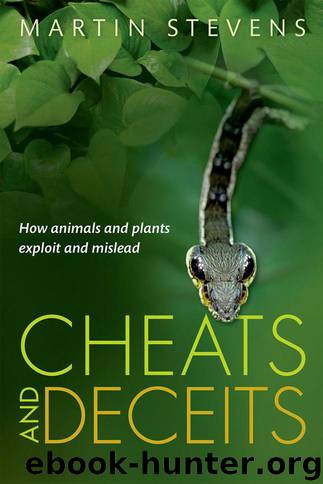Cheats and Deceits: How Animals and Plants Exploit and Mislead by Martin Stevens

Author:Martin Stevens [Stevens, Martin]
Language: eng
Format: epub, azw3
ISBN: 9780198707899
Publisher: OUP Oxford
Published: 2016-02-03T17:00:00+00:00
Fig. 42. The colourful wings and eyespots of the peacock butterfly (Aglais io). Experiments have shown that their startle displays and eyespots are very effective in deterring avian attacks.
Image © lianem/123RF
It was almost fifty years later that clear evidence finally showed that eyespots do genuinely startle birds. Adrian Vallin and colleagues at Stockholm University essentially repeated Blest’s experiments but under much more effectively controlled conditions and without the problems of Blest’s manipulations.12 They presented peacock butterflies to captive blue tits in laboratory rooms and recorded their interactions, including how likely the butterflies were to be eaten. In some individuals Vallin painted over the eyespots with a permanent black marker, whereas other individuals were painted on a different region of the wing away from the eyespots (this acted as a control for the manipulation of the eyespots potentially affecting the butterfly display). The trials showed clearly that eyespots were strongly effective against the birds. In thirty-four trials with butterflies with their eyespots intact, just one individual was killed. In contrast, thirteen out of twenty butterflies with the eyespots removed were killed, demonstrating how valuable the spots are over and above the other display components. What’s remarkable is that the experiments were conducted in a small room, roughly two metres wide, and the trials lasted a whole thirty minutes (unless a butterfly was eaten), yet just one butterfly with eyespots was killed across all trials. In many cases, birds repeatedly approached motionless butterflies yet were continuously deterred by the subsequent startle display. Thus, the effect was strong and prolonged. Interestingly, however, the team’s manipulations of the butterfly wings to prevent them making the hissing sound did not affect the birds’ willingness to attack, further suggesting that the acoustic component of the startle display is directed towards rodents rather than birds.
Vallin and colleagues then undertook another similar set of experiments whereby they presented both peacock butterflies and eyed hawk-moths (Smerinthus ocellatus) with and without eyespots to blue tits and great tits in aviaries.13 Eyed hawk-moths are large moths with a pair of black and blue/white eyespots on their hindwings, surrounded by red coloration (Figure 43). Their display differs somewhat from that of the peacock, with the moths opening their wings when threatened and often rocking their body and wiggling around in the same place, keeping the eyespots visible throughout. The study again showed that eyespots work in deterring birds, but the display of the two species was not the same because birds were more wary of the peacock than the hawk-moth. It is hard to know, however, whether this stems from peacock butterflies having more spots than the eyed hawk-moths (four instead of two), different spot colours, or differences in display behaviour.
Download
Cheats and Deceits: How Animals and Plants Exploit and Mislead by Martin Stevens.azw3
This site does not store any files on its server. We only index and link to content provided by other sites. Please contact the content providers to delete copyright contents if any and email us, we'll remove relevant links or contents immediately.
| Anatomy | Animals |
| Bacteriology | Biochemistry |
| Bioelectricity | Bioinformatics |
| Biology | Biophysics |
| Biotechnology | Botany |
| Ecology | Genetics |
| Paleontology | Plants |
| Taxonomic Classification | Zoology |
Sapiens: A Brief History of Humankind by Yuval Noah Harari(14320)
The Tidewater Tales by John Barth(12626)
Mastermind: How to Think Like Sherlock Holmes by Maria Konnikova(7278)
Do No Harm Stories of Life, Death and Brain Surgery by Henry Marsh(6905)
The Thirst by Nesbo Jo(6879)
Why We Sleep: Unlocking the Power of Sleep and Dreams by Matthew Walker(6655)
Life 3.0: Being Human in the Age of Artificial Intelligence by Tegmark Max(5516)
Sapiens by Yuval Noah Harari(5323)
The Longevity Diet by Valter Longo(5042)
The Body: A Guide for Occupants by Bill Bryson(5029)
The Rules Do Not Apply by Ariel Levy(4910)
The Immortal Life of Henrietta Lacks by Rebecca Skloot(4550)
Animal Frequency by Melissa Alvarez(4428)
Why We Sleep by Matthew Walker(4394)
The Hacking of the American Mind by Robert H. Lustig(4339)
Yoga Anatomy by Kaminoff Leslie(4333)
All Creatures Great and Small by James Herriot(4271)
Double Down (Diary of a Wimpy Kid Book 11) by Jeff Kinney(4240)
Embedded Programming with Modern C++ Cookbook by Igor Viarheichyk(4141)
